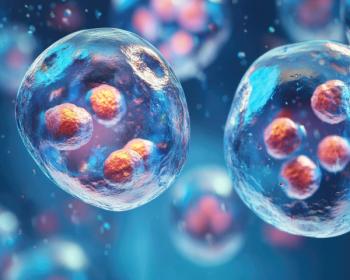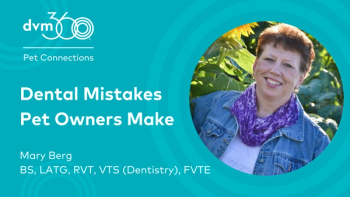
Anatomy and charting (Proceedings)
Being aware of dental formulas, oral anatomy as well as terminology is crucial to proper charting.
Being aware of dental formulas, oral anatomy as well as terminology is crucial to proper charting.
General nomenclature:
• Maxilla - Upper Jaw
• Mandible - Lower Jaw
• Gingiva - Gum tissue
• CEJ - Cemento-Enamel Junction
• Sulcus - Area between free gingiva and tooth
• Subgingival - Below gingiva
• Supragingival - Above gingival
• Labial – surface of incisors towards lips
• Buccal – surface of premolars and molars facing the cheek
• Palatal – Maxilla
• Lingual – Mandible
• Mesial – toward the center
• Distal – away from center
• Coronal – crown
• Apical – toward apex
• Occusal – chewing surface
• Gingival – toward gingiva
• Interproximal – between teeth
Head type of the animal as well as malocclusions need to be noted.
o Mesocephalic – common head type. Meso means medium and cephalic refers to the head.
o Mesocephalic breeds are Laboradors, Beagles, and domestic shorthair cats.
o Brachycephalic – brachy means short. Brachycephalic animals have a short and wide skull. This commonly results in crowded and rotated premolars. Brachycephalic breeds are Pugs, Boxers, and Persian cats.
o Dolichocephalic – dolicho means long and straight. These are animals with long, narrow heads and very long and thin muzzles. Dolichocephalic breeds are Dachshunds, Collies, and Siamese cats.
Tooth types
o Incisors – there are 6 incisors in the maxilla and six in the mandible. Incisors are for tearing, nibbling and grooming.
o Canine – there are two canines in each the maxilla and the mandible. Canine teeth are used to grabbing, tearing food and protection. Each canine has one root. The root is approximately 2/3 as long as the visible crown.
o Premolars- the premolars are located behind the canine tooth. In dogs, there are four premolars in each side of the maxilla and mandible. In cats, there are three premolars in the maxilla and two premolars in the mandible. Premolars can have one, two or three roots in the maxilla and one or two roots in the mandible. Premolars are used to hold and cut food into digestible pieces.
o Molars – molars are located behind the premolars. In dogs there are two molars on each side of themaxilla and three molars on each side of the mandible and may have one, two or three roots. Cats have one tiny molar on each side of the maxilla and one molar on each side of the mandible and may have one or two roots.
Dental formulas:
It is imperative that individuals performing dentistry know the number of roots for each tooth.
In human dentistry, there is one universal tooth identification system, however in the veterinary world there are many identification systems currently being used. The anatomical system uses the first letter of each tooth type along with a number to identify each tooth. The advantage of the anatomical system is that it is easy to remember and many teeth can be identified at one time. The disadvantages are that is can be more time consuming to identify individual teeth and some computer systems may not be alpha numeric friendly.
The Triadan numbering system gives each tooth a three digit number. The first digit represents the quadrant of the mouth and the other two numbers represent the tooth identification. The rule of 4 & 9 helps to identify the teeth. The number 04 is always given to the canine tooth and the number 09 is always given to the first molar. The advantages of the Triadan system is that it is quicker to say and can be used with most computers. The disadvantages are that it is not intuitive and that you must know the code. This system is gaining in popularity.
It is important to be able to identify oral pathology and anomalies. It is equally important to correctly record the pathology on dental charts. A thorough dental examination includes both conscious and anesthetized examinations as well as charting disease processes, pathology and anomalies, and treatment plans.
Periodontium consists of
o Gingiva
o Periodontal Ligament
o Cementum
o Alveolar Bone
Why is dental charting important? A dental chart is a diagrammatic representation of the dentition where information can be entered in a pictorial and/or notation format. It allows you to keep a record of the patient's oral health, track changes in oral health and record treatment. A dental chart is also a legal document.
In order to ensure efficient record keeping the chart should include: a chart with a key, brief descriptions to clarify disease and treatments, procedure preformed, therapeutic plan, prognosis and photographs. These can be in either a fill in or check off format. The chart needs to have basic vital information that is similar to the items needed in all veterinary records. There are commercially available dental charts available but you can develop your own.
Important terms:
• Occlusion – the way teeth fit together
• Furcation – are where roots join
• Recession – loss of gingival tissue
• Inflammation – swelling, redness, infection
• Pocket – pathological area between gingiva and tooth surface
• Hyperplasia – excessive gingival tissue
• Supernumerary – too many teeth
• Mobility – tooth moves
Oral examination
An oral examination on a conscious patient is important but often limited to a visual inspection and digital palpation. The examination involves more than just the oral cavity. Palpation of the facial bones and zygomatic arch, temporomandibular joint, salivary glands and lymph nodes are also important. Dental occlusion should also be evaluated. This can be done by gently retracting the lips to look at the soft tissue, the bite and the buccal aspects of the teeth.
Once the animal is anesthetized, a thorough oral examination can be completed. All the structures of the oral cavity must be evaluated to include the oropharynx, lips and cheeks, mucous membranes, hard palate, floor of the mouth and tongue as well as the teeth. The periodontium (gingival, periodontal ligament, cementum and alveolar bone) of each tooth needs to be evaluated. In animals with large amounts of calculus on the teeth, it may be necessary to remove these deposits to accurately access the periodontium. The use of a calculus removal forceps is a recommended method to remove supragingival calculus. Use care when using this instrument to ensure that the gingivia and tooth crown are not damaged.
When evaluating the periodontium a periodontal probe, a dental explorer and a dental mirror are used. The following indices should be evaluated for each tooth; gingivitis, periodontal probe depth, gingival recession, furacation involvement, mobility and periodontal attachment levels.
The amount of plaque observed on the teeth prior to cleaning should be recorded. Because plaque is the soft, gelatinous matrix of bacteria and bacterial by-products that lead to gingival irritation and gingivitis it may be necessary to use a disclosing agent to visualize. Calculus (tartar) is calcified plaque. The amount of calculus should be recorded as light, moderate or heavy. Calculus can only be removed by either hand scaling or power scalers.
Gingivitis index (gi):
The gingival index (GI) is a measurement of gingival health. The assessments of gingival changes are scored using the following criteria.
0 - normal healthy gingiva
1 - moderate inflammation, moderate redness, not bleeding on probing, edema
2 - moderate inflammation, moderate to severe redness, edema, bleeding upon probing
3 - severe inflammation, severe redness, edema, ulceration, spontaneous bleeding
Each tooth is given the most severe score.
Probe depth (pd):
Probe depth (PD) is a measure of the depth the periodontal pockets often found in periodontal disease. The probe depth is measured at multiple sites of the tooth. A periodontal probe with millimeter markings is gently placed between the free gingival and the tooth surface, and carefully advanced until soft tissue resistance is felt. The tip of the probe should be parallel to the long axis of the tooth. The pocket depth is recorded as the distance in mm from the free gingival margin to the bottom of the pocket. The probe may be glided or walked along the tooth to measure the varying pocket depths. A normal gingival sulcus depth is 1-3 mm in dogs and 0.5 to 1mm in cats. Measurements in excess of these values should be recorded in the appropriate location on the dental chart.
Gingival recession:
Gingival recession is also measured with the periodontal probe. It is the distance from the cemento-enamel junction to the margin of the free gingiva. At sites with gingival recession the probe depth may be normal despite the loss of alveolar bone. Areas of gingival recession should be noted on the dental chart.
Furcation Index (FI):
The furcation index (FI) measures the loss of bone support in multi-rooted teeth. A periodontal probe is placed perpendicular to the long axis of the tooth and slid along the free marginal groove to the furcation site. The following criteria are used to assign a numerical score.
0- no loss of bone support
1- horizontal loss of supporting tissues not exceeding one-third of the width ofthe tooth
2- horizontal loss of supporting tissues exceeding one-third of the width of the tooth but no encompassing the total width of the furcation area.
3- horizontal through and through loss of supporting tissue. A furcation index of 1-3 should be noted on the dental chart.
Mobility index (mi):
The mobility index (MI) measures the loss of bone support by indicating the amount of movement of the tooth. The length of the periodontal probe is placed on the buccal surface of crown of the tooth and gentle pressure is applied to the tooth. The following criteria are used to assign a numerical score.
0 - no mobility
1- perceptible mobility but less than 1 mm buccolingually
2- definite mobility between 1-2 mm
3- gross mobility exceeding 2 mm buccolingually and/or vertical mobility
A mobility index of 1-3 should be noted on the dental chart.
Periodontal attachment level (pal)
This measurement is similar to the Probe depth measurement. In the PAL the pocket depth is measured from the base or apex of the pocket to the cemento-enamel junction. This is a more accurate assessment of tissue loss in periodontitis. PAL can be directly measured or it can be calculated as the sum of PD plus gingival recession.
Probe depth (aka – pocket depth) is an important part of charting. This loss of attachment is created by the progression of periodontal disease and therefore a vital piece of information. The normal healthy mouth has a probe depth of 1-3 mm in dogs and 1 mm or less in cats. Any probe depth greater than this should be recorded on the chart. The probe should be walked around all sides of the tooth to ensure all pockets are recorded.
Furcation exposure
In multi-rooted teeth, the area where the roots meet is referred to as the furcation. The bone loss caused by periodontal disease often affects this area early in the disease process. The presence of furcation involvement should be evaluated and recorded as Grade 0 – 3 depending upon the amount of involvement.
Stage of Periodontal Disease
The stages of periodontal disease can be used to help price your periodontal therapies but also need to be recorded so that the progression of disease can be determined. These stages are determined by either measuring clinical attachment level or radiographically.
• Stage 1 -Gingivitis only with attachment loss.
• Stage 2 - Less than 25% attachment loss. Grade 1 furcations present.
• Stage 3 - 25 to 50% attachment loss. Grade 2 furcations present
• Stage 4 - Over 50 % attachment loss. Grade 3 furcations present.
Oral masses need to drawn onto the chart and noted. This includes epuli and gingival hyperplasia. This is important to note these in order to have a record of the mass and be able to note changes in future examinations as well as gingivectomies or the removal of excess gingival tissues.
References
Logan, EI, Boyce EN: Oral Health Assessment in Dogs: Parameters and Methods. J. Vet Dent 11(2): 58-63.
Harvey, CE, Emily, PP: Periodontal Disease. In Harvey, CE, Emily, PP: Small Animal Dentistry. St. Louis:Mosby, 1993
Logan, EI, Finney, O, Hefferren, JJ: Effects of a Dental Food on Plaque Accumulations and Gingival Health in Dogs. J Vet Dent 19(1), 15-18.
Holmstrom, SE: Veterinary Dentistry for the Technician and Office Staff. W.B. Saunders Company, 2005.
Gorrel, C: Veterinary Dentistry for the General Practitioner. Saunders, 2004
Lobprise, H: Clinical Companion, Five Minute Consult - Small Animal Dentistry, Blackwell, 2007.
Newsletter
From exam room tips to practice management insights, get trusted veterinary news delivered straight to your inbox—subscribe to dvm360.






